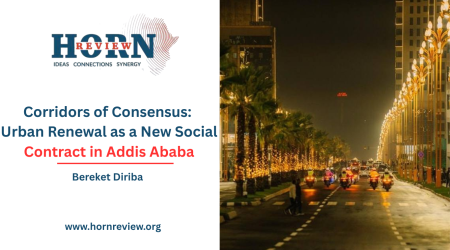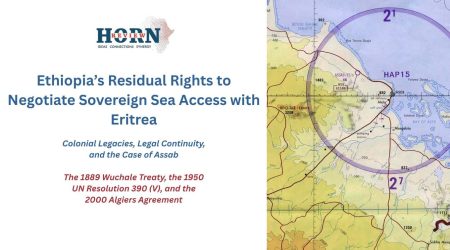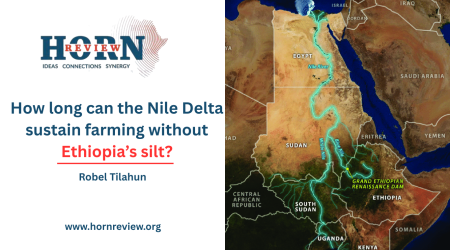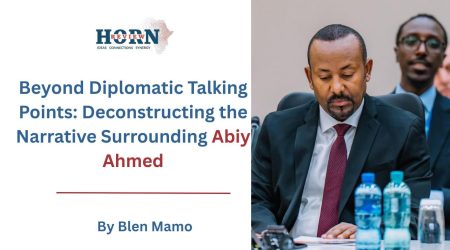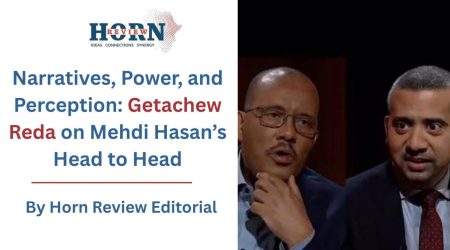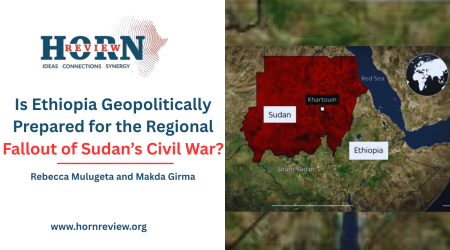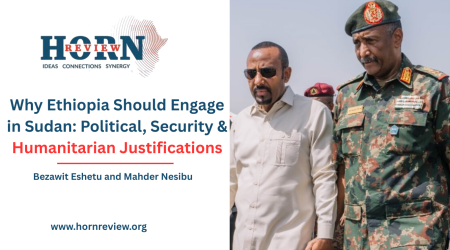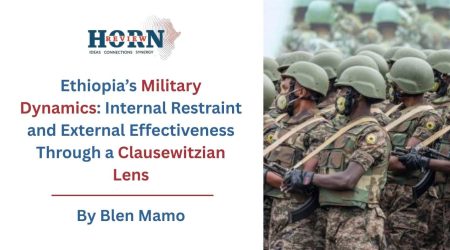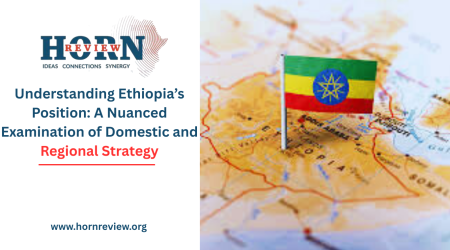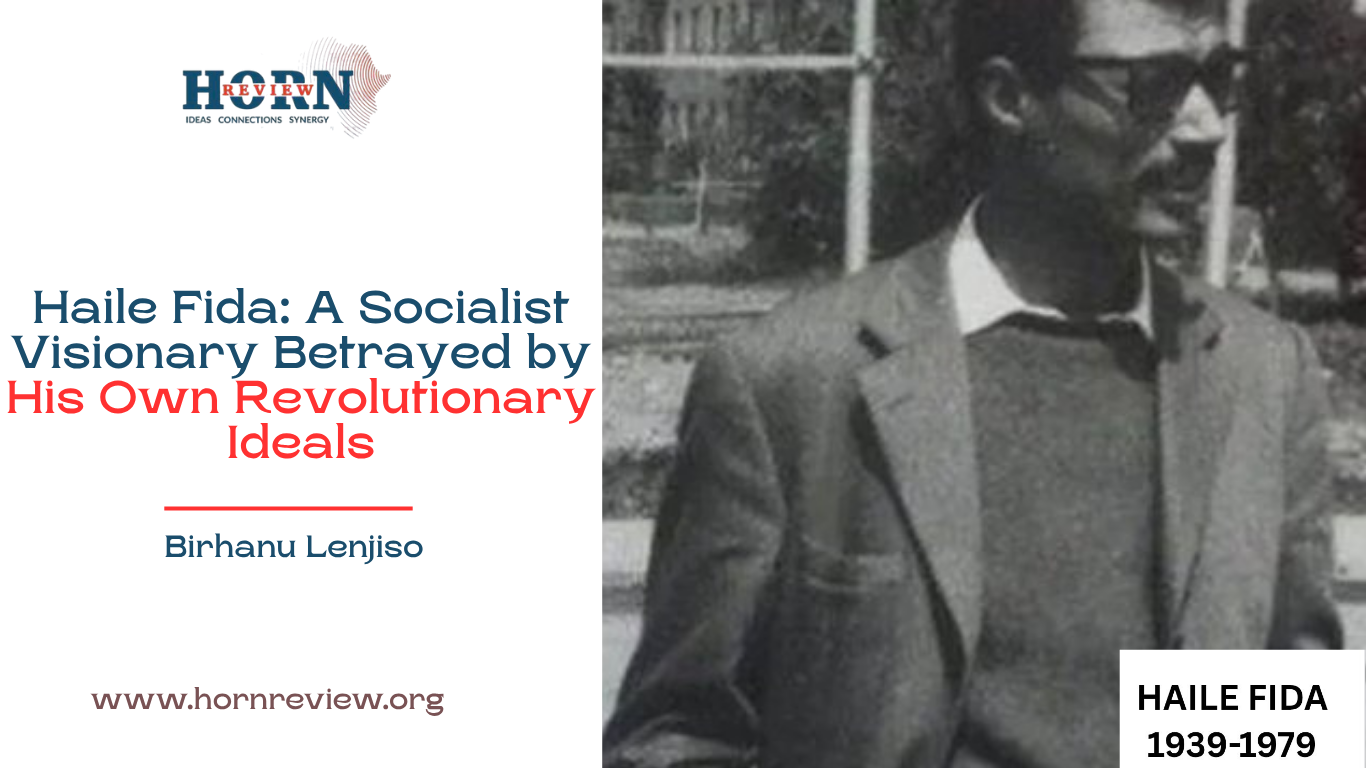
15
Oct
Haile Fida: A Socialist Visionary Betrayed by His Own Revolutionary Ideals
My introduction to Haile Fida came not from books or historical records but through a chance encounter with Amare Tegbaru, his former cellmate in 2016. At the time, we were both working for the Consortium Group for International Agricultural Research (CGIAR) and we met in the vibrant city of Penang, Malaysia. Over conversations in that tropical haven, Amare shared vivid stories of Haile’s life, painting a portrait of a revolutionary intellectual driven by fierce idealism. He spoke passionately of Haile’s vision and mentioned he was writing a book about his life and legacy. Intrigued, I was eager to learn more. Upon returning to the United States, I spoke with another friend who had also been imprisoned with Haile, but his account was starkly different, casting doubt on Amare’s narrative and urging me not to trust it entirely. Unraveling Haile’s story proved challenging, as even those who knew him best have contradictory tales, reflecting the elusive legacy of a figure both celebrated and condemned in Ethiopia’s turbulent history.
Haile Fida remains a towering yet polarizing figure in Ethiopia’s revolutionary saga, embodying the idealism and tragedy of the Ethiopian Revolution. Born to a peasant family in Arjo, he emerged as an Oromo linguist, Marxist ideologue, and key architect of the All-Ethiopian Socialist Movement (MEISON). His audacious vision to dismantle Ethiopia’s feudal order and create a classless, ethnically inclusive socialist state shaped the Derg’s ideological framework, yet it was as flawed as it was ambitious. His life ended abruptly in 1979 under mysterious circumstances, some say he was executed by the regime he helped shape, while others claim he was betrayed by comrades. Haile is remembered in contradictory ways: a visionary hero to some, a misguided ideologue to others, and a traitor to those who felt his Derg alliance betrayed the revolution’s ideals.
For our generation, writing about Haile is a daunting task. Conflicting narratives, woven from personal accounts, political biases, and fragmented histories, obscure the truth. Was he a martyr for justice or a casualty of his uncompromising ideals? The stories I heard reflect this divide, each a piece of an unresolved puzzle. But his life definitely challenges us to confront the complexities of revolution, identity, and legacy in Ethiopia – a country still grappling with its past. In this piece, I will examine Haile’s legacy through six pivotal memories; three from his formative years and three from his execution and enduring impact, integrating contemporary accounts, both laudatory and condemnatory, to present a balanced portrait. The article draws on historical records, memoirs, and scholarly analyses and argues that Haile’s life reflects the paradox of revolution: a noble pursuit that often devours its champions, as his execution grimly attests. The conclusion reflects on the revolution’s tendency to consume its architects, underscoring the need for critical vigilance in assessing the legacies of revolution in Ethiopia.
Haile’s Root in Arjo – A Peasant’s Son with Revolutionary Zeal
Haile’s origins in Arjo, Oromia, is believed to have shaped his revolutionary fervor. Born around 1939, into a peasant family, he grew up amid the inequities of Ethiopia’s feudal system, where Oromo farmers toiled under landlords. Additionally, the systemic marginalization of Oromo language and culture is believed to have instilled in him empathy for the dispossessed. His early education at Arjo Primary School and Haile Selassie I Secondary School in Nekemte revealed a prodigious intellect. Amare for instance indicated that teachers noted his “relentless curiosity” and ability to question “not just facts, but the structures behind them” (Tegbaru, 2015).
Haile’s rural roots lent him authenticity, praised by his colleagues who described him as “a son of the soil whose heart beat for the peasant’s plight” (Tegbaru, 2015). Yet, critics argue his authenticity masked dangerous idealism. EPRP member Dawit Shifaw scorned Haile’s “romanticized view of the peasantry,” accusing him of “projecting Marxist fantasies onto a complex reality” (Shifaw, 1989). But in general, Haile’s early years grounded his intellectual journey, forging a revolutionary who spoke the language of both the plow and the pen.
Haile’s Global Education: From Geologist to Revolutionary Sociologist
Haile’s intellectual journey was a remarkable transformation. A star student at General Wingate School in Addis Ababa, he graduated with honors in geology from Haile Selassie I University in the early 1960s. Later scholarship led him to Europe, where he initially pursued astronomy. However, the revolutionary fervor of 1960s Paris shifted his trajectory. At the Sorbonne’s Institut Universitaire de France, Haile earned an MA in sociology and social anthropology, followed by a PhD in philosophy. Immersed in Marxist texts and French Communist Party circles, he fused Soviet socialism with Oromo nationalism, becoming a radical voice for change.
His linguistic contributions were equally bold. Works like Languages in Ethiopia: Latin or Ge’ez for Writing Afaan Oromo (1972) and Hirmaata Dubbi Afaan Oromoo (1973, co-authored) advocated Latin script for Oromo orthography, a defiant act of cultural reclamation. Haile’s European education drew both praise and criticism. Oromo scholars hailed him as a polymath who bridged continents and disciplines, amplifying the silenced. In contrast, EPRP critics like Berhane Meskel Redda derided him as “a Parisian dilettante, enamored with foreign theories unfit for Ethiopia’s realities” (Redda, 1985). Returning to Ethiopia in 1975, Haile co-founded the Progressive Book Store, making Marxist texts accessible to students. His education defied intellectual boundaries, blending global ideas with local struggles to challenge Ethiopia’s feudal order.
MEISON and the Derg – Haile’s Ideology in the Crucible of Power
Haile’s unique ideological synthesis, Soviet socialism infused with Oromo nationalism, found its stage in the All-Ethiopian Socialist Movement (MEISON), co-founded in 1968 during the Ethiopian Student Union in Europe congress. Unlike the Ethiopian People’s Revolutionary Party (EPRP), which rejected the Derg’s 1974 coup, MEISON pursued a tactical alliance, believing the military could safeguard the revolution until civilians assume leadership. As chairman of the Provisional Office for Mass Organizational Affairs (POMOA), Haile orchestrated peasant associations and urban kebeles, embedding socialist principles at the grassroots. His Program for the National Democratic Revolution (1976) outlined land reform, anti-feudal purges, and ethnic self-determination, earning him praise as “a blueprint for equitable Ethiopia” (Kebede, 1999).
Haile’s role as the Derg’s ideological tutor was both celebrated and reviled. MEISON cadre Tesfaye Debessay hailed him as “the revolution’s conscience, teaching soldiers to dream beyond rifles” (Debessay, 2010) while EPRP survivors like Hiwot Teffera condemned him as “a collaborator who armed Mengistu’s terror with Marxist rhetoric” (Teffera, 2012). MEISON’s growing influence alarmed Mengistu, setting the stage for Haile’s tragic fall.
Haile’s Betrayal and Execution – The Revolution’s Grim Harvest
The Derg’s paranoia shattered Haile’s vision for Ethiopia. By mid-1977, MEISON’s influence over mass organizations threatened Mengistu’s grip on power. In March 1977, a ministerial reshuffle marginalized MEISON allies and by July, POMOA was wrested from their control. In August, Haile and 500 cadres fled underground, seeking refuge in Wallaga. Unfortunately, they were captured in the same month near Entoto, Addis Ababa and Haile was imprisoned in the Old Gebbi palace, enduring months of brutal torture. It was believed he was executed around April in 1979, his death, cloaked in secrecy, epitomized the revolution’s betrayal of its intellectuals.
Accounts of Haile’s demise reflect deep divisions. MEISON ally Negede Gobeze, who fled to Yemen, mourned him as “a martyr sacrificed to Mengistu’s ego” (Gobeze, 1988). Conversely, EPRP’s Kiflu Tadesse blamed Haile for “sowing the seeds of his own destruction by empowering a tyrant” (Tadesse, 1998). His execution, unacknowledged publicly, underscored the Derg’s ruthless purge of its visionaries, a stark warning that revolutions often devour their brightest minds. Yet, despite this devastating history, many Ethiopians remain enamored with the idea of revolution, equating political change with radical upheaval. This mindset, rooted in the belief that only total transformation can reshape the nation, overlooks the grim lessons of the past. The bloodshed and betrayal of figures like Haile Fida reveal the cost of such fervor. Ethiopia must learn from these tragedies, embracing incremental change that fosters stability and progress without sacrificing lives. By valuing measured reforms over revolutionary zeal, Ethiopians can honor their history while building a future free from the cycles of violence that once consumed their visionaries.
Qubee’s Triumph: Haile Fida’s Enduring Linguistic Legacy
Haile Fida’s remarkable journey from geologist to sociologist culminated in a transformative linguistic legacy that reshaped Oromo identity. His advocacy for the Latin-based Qubee script revolutionized Oromo orthography, fostering literacy and cultural pride. His seminal work, “Hirmaata Dubbi Afaan Oromoo”, standardized Oromo phonemes, an achievement Oromo scholars describe as “a decolonizing act that gave millions their voice” (Hassen, 1998). Formally adopted in the 1990s, Qubee transformed education and media across Oromia, empowering a nation to embrace its linguistic heritage.
Despite his execution, Haile’s vision endured. In 2020, Wollega University honored him by naming its Afaan Oromoo Academy after him, cementing his title as the “Father of Qubee.” In 2025, the Oromo Research Association posthumously recognized his contributions, celebrating his intellectual rigor and cultural empowerment. However, critics, like the late Getachew Haile, argued Qubee “fueled ethnic division under the guise of liberation” (Haile, 2005). Yet, these critiques are overshadowed by Qubee’s profound impact. Haile’s transition from geology to sociology equipped him with a unique perspective, enabling him to craft an enduring linguistic blueprint that continues to unify and uplift the Oromo people.
Haile Fida’s Contested Legacy: Hero, Red-Gobana, Fidist, or Tragic Idealist?
Haile Fida’s legacy, shaped by his Oromo roots, academic journey from geologist to sociologist, and Marxist convictions, remains deeply contested in Ethiopia’s revolutionary narrative. Celebrated by some as a cultural hero and vilified by others as a traitor, his contributions, most notably the Qubee script, and his role in the socialist era ignite fierce debate. The labels “Hero,” “Red-Gobana,” “Fidist,” and “Tragic Idealist,” rooted in Ethiopia’s complex ethno-political landscape, capture the polarized views of his life and enduring impact.
Hero: Architect of Oromo Empowerment: Oromo scholars and MEISON veterans revere Haile as a transformative figure whose Qubee script standardized Oromo phonemes, fostering literacy and cultural pride. His work, described as “a decolonizing act” (Hassen, 1998). His socialist advocacy within MEISON laid ideological foundations for Ethiopia’s federal structure, promoting ethnic autonomy (Tegbaru, 2015). Posthumous honors and recognitions solidify his legacy as a champion of Oromo identity.
Red-Gobana: Betrayer of Oromo Autonomy: To Oromo Liberation Front (OLF) critics, Haile is a “Red-Gobana,” likened to Ras Gobana Dache, who aided Emperor Menelik II’s conquests. The term merges “red” (symbolizing Haile’s Marxism and the Derg’s Red Terror) with “Gobana,” casting him as a traitor who aligned with northern Ethiopian elites, undermining Oromo self-determination. Critics argue his Derg alliance betrayed Oromo aspirations, echoing historical grievances of ethnic subjugation (Jalata, 2007).
Fidist: Enabler of Derg Violence: EPRP survivors and Red Terror victims brand Haile a “Fidist,” a pejorative derived from his surname, akin to “Leninist,” accusing him of rigid Marxism that enabled the Derg’s brutal purges. His early support for the regime, critics claim, legitimized its violence against dissenters. Survivor Genet Ayele called him “a brilliant monster whose ideas justified slaughter” (Ayele, 2014), reflecting resentment deepened by the silence of contemporaries wary of his polarizing legacy.
Tragic Idealist: A Vision Undone by Power: Historian Bahru Zewde portrays Haile as a tragic idealist, embodying “the revolution’s contradictions” (Zewde, 2014). His journey from geologist to sociologist equipped him to craft Qubee and advocate socialist reforms, yet his Derg alliance entangled him in its repression. Executed by the regime he supported, Haile’s idealism, a vision for cultural and political empowerment, was undone by revolutionary chaos, rendering him a complex figure whose ambitions were thwarted by brutal politics.
A Divisive Figure in Ethiopia’s Narrative: The labels “Hero,” “Red-Gobana,” “Fidist,” and “Tragic Idealist” reflect Ethiopia’s fractured ethno-political discourse, rooted in historical grievances and the socialist era’s violent legacy. Haile’s absence from official narratives contrasts with his reverence in Oromo academic circles and vilification by EPRP survivors, underscoring his divisive stature. Debates over his motives, cultural empowerment, ethnic betrayal, ideological extremism, or tragic idealism, mirror Ethiopia’s struggle to reconcile its socialist past with its federal present. Haile’s name, confined to Oromo pride and academic footnotes, remains a specter of unrealized potential, embodying the promise and peril of Ethiopia’s revolutionary era.
Conclusion: Ethiopian Revolution That Devours Its Children
Haile Fida’s life and death serve as a stark parable of the Ethiopian Revolution’s tendency to devour its own, a pattern that continues to haunt Ethiopia’s collective psyche. His journey, from a brilliant scholar shaped by Wallaga’s roots and Paris’s intellectual crucible to a revolutionary leader executed by the very Derg regime he aligned with, encapsulates the revolution’s tragic irony. Fida’s vision of a socialist Ethiopia, where peasants and diverse nationalities could thrive, was consumed by the chaos and betrayal inherent in revolutionary upheaval. Yet, despite the devastation wrought by the 1974 revolution and subsequent upheavals, marked by bloodshed, economic collapse, and fractured communities, Ethiopians retain a fervent revolutionary spirit. This persistent zeal, evident in ongoing calls for radical change amid ethnic tensions and political strife, reflects a belief that only sweeping, transformative action can address systemic inequities. However, this fervor often overlooks the revolution’s cost: a cycle of violence and instability that has repeatedly undermined the nation’s progress, leaving scars that linger in Ethiopia’s post-socialist identity.
The enduring allure of revolution in Ethiopia must be tempered by a commitment to incremental change and peaceful solutions, as the zero-sum nature of revolutionary pursuits continues to exact a heavy toll. Haile Fida’s legacy, celebrated for his linguistic contributions to Oromo identity, yet criticized for his political miscalculations, demands rigorous reflection, not to glorify or condemn, but to illuminate the perils of radicalism unchecked. Each revolutionary wave, from the Derg’s rise to recent ethnic and political conflicts, has promised liberation but delivered destruction, deepening divisions rather than fostering unity. Embracing gradual reforms, grounded in dialogue and compromise, offers a path to address Ethiopia’s challenges without sacrificing more lives to the altar of revolution. As Ethiopia grapples with its complex identity, Haile’s story serves as a cautionary tale: revolutions, while born of noble dreams, risk consuming their architects and their aspirations, leaving behind lessons that urge patience, pragmatism, and peace over the seductive but destructive call to arms.
References
Ayele, G. (2014). Red Terror Diaries. Addis Ababa: Self-published.
Debessay, T. (2010). Revolution and Remembrance. London: Exile Press.
Gobeze, N. (1988). Exile’s Account: MEISON’s Fall. Sana’a: Yemen Press.
Haile, G. (2005). Ethiopia’s Ethnic Faultlines. Addis Ababa: Unity Press.
Hassen, M. (1998). The Oromo of Ethiopia: A History. Trenton: Red Sea Press.
Jalata, A. (2007). Oromia and Ethiopia: State Formation and Ethnonational Conflict. Boulder: Lynne Rienner.
Kebede, M. (1999). Survival and Modernization: Ethiopia’s Enigmatic Present. Asmara: Red Sea Press.
Redda, B. M. (1985). The EPRP Chronicles. London: Zed Books.
Shifaw, D. (1989). Against the Grain: EPRP’s Struggle. Washington: Self-published.
Tadesse, K. (1998). The Generation: The History of the EPRP. Trenton: Red Sea Press.
Tegbaru, A. (2015). Haile Fida ena YeGille Tizita. Addis Ababa: Far East Press.
Zewde, B. (2014). The Quest for Socialist Utopia: The Ethiopian Student Movement. Woodbridge: James Currey.
By Birhanu Lenjiso, PHD
______________________________________
Birhanu M. Lenjiso is an Ethiopian sociologist and policy expert with a PhD in Social Sciences from Radboud University Nijmegen and a BA and MA in Sociology from Addis Ababa University. He is also the author of the book “ብሄርተኝነት” and an active commentator on Ethiopian politics and Horn of Africa affairs

